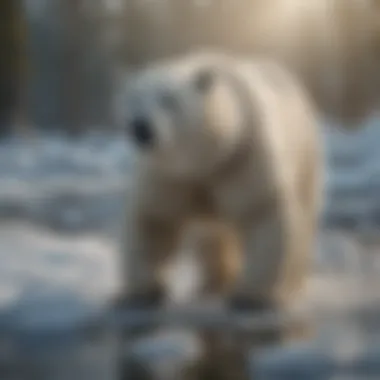Endangered Animals and Climate Change: The Urgent Link


Intro
Climate change is reshaping our planet in profound ways, affecting ecosystems and wildlife across the globe. This discussion centers around how shifts in climate patterns threaten numerous animal species. Various factors, such as rising temperatures, changing precipitation patterns, and habitat loss, combine to create an urgent crisis for biodiversity.
Understanding the intricate relationships between climate change and animal endangerment is essential for effective conservation efforts. This exploration aims to provide a detailed perspective on these issues, illustrated through case studies and ongoing research, ultimately equipping conservationists and policymakers with the necessary insights to advocate for our planet's wildlife.
Understanding Forestry Practices
Forestry practices play a critical role in managing natural resources, influencing both climate and biodiversity. As such, a clear understanding of these practices is vital in the discourse on endangered species and climate change.
Types of Forestry Practices
Forestry can be classified into several distinct practices:
- Even-aged management: This method focuses on creating uniform age classes in forests. It allows for easier management but can reduce habitat complexity.
- Uneven-aged management: This technique maintains a mix of age classes, promoting biodiversity and stability in ecosystems.
- Selective logging: This involves carefully choosing which trees to fell, minimizing damage to the surrounding forest. It is more sustainable but requires skilled management.
Historical Context
Historically, forestry practices have evolved from exploitation-focused approaches to more sustainable management philosophies. The recognition of the importance of forests in climate regulation and biodiversity has led to the adoption of better practices. However, these developments come amidst ongoing challenges. Deforestation, primarily driven by agriculture and urban expansion, remains a critical issue.
"Forests are the lungs of our planet, vital for storing carbon and maintaining ecological balance."
Principles of Woodland Stewardship
Woodland stewardship emphasizes the responsibility to manage forests sustainably. It involves a set of principles that guide conservation practices to promote resilience amidst changing climatic conditions.
Conservation Techniques
Effective conservation strategies enhance ecological health and mitigate climate impacts. Techniques include:
- Reforestation: Planting trees in deforested areas helps restore habitats and sequester carbon.
- Forest reserves: Establishing protected areas can safeguard critical habitats, allowing diverse species to thrive.
- Wildlife corridors: Creating links between fragmented habitats supports species movement and genetic diversity.
Managing Forest Resources
Proper resource management involves understanding the balance between utilization and conservation. It necessitates comprehensive monitoring and adaptive management approaches that accommodate shifts in ecosystem dynamics due to climate change.
Sustainable Forest Management
Sustainable forest management is critical in addressing the challenges posed by climate change. It focuses on maintaining forest health and productivity while providing social and economic benefits.
Certification Standards
Several certification standards exist to ensure responsible forestry practices. Programs like the Forest Stewardship Council (FSC) and the Sustainable Forestry Initiative (SFI) promote well-managed forests through rigorous standards.
Economic Benefits of Sustainability
Sustainable practices can drive economic growth while preserving natural resources. Benefits include:
- Job creation: Sustainable forestry supports local economies by providing stable employment in forestry and conservation sectors.
- Ecosystem services: Healthy forests provide essential services, such as clean water and climate regulation, which translate to long-term community benefits.
Understanding these principles and practices helps bridge the gap between forestry and wildlife conservation in the context of climate change. A collaborative approach that values both ecosystems and economic needs is essential to safeguarding our planet's future.
Prelude to Endangered Species
The concept of endangered species is vital in understanding the broader impacts of environmental changes. As humanity faces the repercussions of climate change, recognizing which species are at risk is crucial for biodiversity and ecological balance. An endangered species is defined as one that is at risk of extinction. This can occur for various reasons, including habitat loss, changes in climate, and human activities that disrupt natural ecosystems.
Defining Endangered Species
Defining endangered species involves specific criteria, often guided by organizations such as the International Union for Conservation of Nature (IUCN). The IUCN's Red List classifies species based on their risk of extinction. Categories include critically endangered, endangered, and vulnerable among others.


A species is considered endangered when its population has decreased significantly, risking its survival. This decline can stem from a combination of factors such as the increasing lead of human-induced climate change. For example, some species might face dwindling food sources, shrinkage of habitats, or increased competition with invasive species.
The Role of Climate Change
Climate change serves as a significant threat to the survival of many endangered animals. Changes in temperature and precipitation patterns disrupt not only habitats, but also the complex food webs and migration patterns within ecosystems. As climates shift, species that cannot adapt quickly enough often find themselves in peril.
According to the latest research, nearly one million species are currently threatened with extinction — a stark indication of the crisis. Climate change exacerbates existing threats like habitat destruction and pollution, making it an urgent factor to address in conservation strategies.
"Understanding the dynamics between climate change and endangered species is essential for effective conservation planning and habitat preservation."
In summary, the introduction of endangered species provides a foundation for exploring the intricate relationship between climate change and wildlife conservation. It highlights the crucial need for immediate action and informed policy-making to ensure biodiversity is preserved for future generations.
Mechanisms of Climate Change Impact
Understanding the mechanisms through which climate change affects wildlife is essential for grasping the broader implications it has on biodiversity. These mechanisms outline how environmental shifts can lead to direct and indirect consequences on various species. Knowledge of these factors can assist wildlife professionals and conservationists in creating effective strategies to mitigate adverse impacts. Therefore, insights gained from assessing these mechanisms inform tailored conservation activities, enhancing their efficiency and effectiveness.
Temperature Rise and Habitat Alteration
As global temperatures rise, many animal species find their habitats are altered dramatically. Species adapted to specific environmental conditions may struggle to survive as their homes transform. For example, polar habitats are becoming less stable due to increased melting of sea ice. This change is crucial for species like polar bears, who rely on this ice for hunting seals, their primary food source.
Beyond polar environments, other ecosystems also suffer. Forests may experience altered growth patterns; some trees may die while others fail to flourish due to increased heat, affecting the entire habitat. As a result, associated species, including birds and insects, may face survival challenges.
Key points regarding temperature rise and habitat alteration include:
- Loss of habitat integrity leads to reduced biodiversity.
- Species migration due to unsuitable conditions can create conflicts over resources in newly co-inhabited areas.
- Many species face extinction if they cannot adapt quickly enough.
Changing Weather Patterns
Climate change is altering weather patterns and increasing the frequency of extreme weather events. This unpredictability poses another significant threat to wildlife survival. Extended droughts, heavy rainfall, and severe storms all impact ecosystems in varied ways. In areas prone to heavier rainfall, flooding can destroy nesting sites for birds and amphibians, leading to population declines.
Additionally, changing weather patterns impact food availability. Some species may find their food sources dwindling due to altered blooming cycles in plants or shifts in prey availability. It's important to recognize how these disruptions may lead to declines in animal populations and biodiversity.
Factors worth noting include:
- Altered reproductive timings due to misaligned seasonal changes.
- Vulnerability of certain species to extreme weather events, leading to habitat degradation.
- Ecosystem resilience is compromised, allowing invasive species to take hold.
Sea Level Rise and Aquatic Species
Sea level rise is one of the most pronounced effects of climate change, directly impacting aquatic ecosystems. Coastal habitats such as mangroves and marshes are vulnerable. These ecosystems serve as critical breeding and feeding grounds for numerous aquatic species. As sea levels rise, these habitats may be submerged, leading to a decline in species that depend on them. Vulnerable species include various fish, birds, and marine mammals.
Aquatic species may also face challenges from salinity changes. Increased salinity can affect freshwater fish and disrupt breeding patterns, potentially leading to population endangerment. Furthermore, some species may find themselves squeezed into smaller areas of habitat, competing more intensely for limited resources.
Considerations regarding sea level rise include:
- Loss of crucial habitats affects species' reproductive success.
- Increased competition for resources can lead to population stress.
- Vulnerability of local fisheries potentially impacts human economies, as well as marine biodiversity.
Understanding these mechanisms highlights the urgency needed for conservation efforts and the importance of addressing climate change in strategic planning.
Wildlife Endangered by Climate Change
Climate change poses a significant threat to wildlife across the globe. As temperatures rise and habitats change, many animal species face dire consequences. The loss of biodiversity can disrupt ecosystems and impact human well-being as well. Understanding which animals are endangered and the factors contributing to their plight is essential for effective conservation efforts.
In this section, we will explore specific examples of wildlife affected by climate change. Each illustration offers insights into the broader impact of climate change on ecosystems. From polar bears in the Arctic to amphibians in tropical rainforests, these cases highlight the interconnectedness of species and their environments.
Polar Bears: Effects of Melting Ice
Polar bears are iconic symbols of climate change. Their habitat is primarily found in the Arctic, where they rely on sea ice to hunt seals. As temperatures increase, the sea ice melts, shrinking their hunting grounds. This loss of habitat forces polar bears to travel further to find food, impacting their health and reproduction rates. With diminishing ice coverage, the survival of polar bears hangs in balance.
The physiological stress from longer fasting periods leads to lower cub survival rates. Furthermore, increased exposure to land increases the likelihood of confrontations with humans, often resulting in conflicts that threaten both bear and human safety.


Coral Reefs: The Impact on Marine Biodiversity
Coral reefs are among the most diverse ecosystems on Earth, supporting thousands of marine species. They are particularly sensitive to temperature changes. Rising ocean temperatures cause coral bleaching, which occurs when corals expel the algae living in their tissues. Without these algae, corals lose their color and their primary source of food.
When reefs decline, so do the fish and other organisms that rely on them for shelter and nourishment. This can lead to the collapse of entire marine communities. The impact of coral reef degradation extends beyond marine life; it also affects coastal protection and local economies dependent on fishing and tourism.
Amphibians: Sensitivity to Environmental Changes
Amphibians, such as frogs and salamanders, are particularly vulnerable to climate change. Their permeable skin makes them susceptible to temperature fluctuations and pollution. Changes in temperature affect their breeding patterns and habitat availability.
Many amphibian species are already facing extinction due to habitat loss and diseases, and climate change exacerbates these pressures. They serve as indicators of environmental health, and their decline signals potential problems that may affect other wildlife and ecosystems.
Bird Migration Patterns Disrupted
Birds are also facing challenges due to climate change. Many species rely on migratory patterns to breed and feed. Changing temperatures and weather patterns can disrupt these historic routes, leading to mismatches between food availability and nesting timing. For instance, some birds may arrive at their breeding grounds when food is scarce, impacting their reproductive success.
In addition, the loss of specific habitats means fewer safe stopovers for migratory birds. Coastal areas, wetlands, and forests are all impacted by climate change, deteriorating the resources these birds rely on during migration.
"Biodiversity is not just vital for the ecosystem health but also critical for human existence. Protecting endangered species is a responsibility we all share."
Addressing the needs of these endangered species requires a concerted effort to mitigate climate change impacts while enhancing conservation methods. Understanding the dynamics of these wildlife can guide initiatives aimed at preserving both species and the ecological integrity of their environments.
Case Studies of Endangered Species
Understanding the plight of specific endangered species offers critical insights into how climate change disrupts ecosystems. These case studies highlight distinct vulnerabilities while providing concrete examples of broader environmental themes. By investigating these species, we can identify specific risks and tailor conservation efforts to address their unique challenges. Moreover, these case studies serve as a representation of the complex interactions between climate factors and wildlife, allowing us to rebuild effective strategies in safeguarding biodiversity.
The Snow Leopard: Mountain Ecosystems at Risk
The snow leopard is a species adapted to the rugged mountain habitats of Central Asia. Its reliance on high-altitude regions makes it particularly sensitive to the changes brought about by climate change. Rising temperatures result in alterations in habitat configuration, forcing these majestic cats to navigate shrinking territories. The melting glaciers, once stable sources of water, now ebb away, impacting not just the snow leopards but the entire ecosystem relying on consistent water flows.
Furthermore, as their habitats become fragmented, snow leopards encounter increased competition with humans and other species.
"Snow leopards are not simply victims of climate change; they symbolize the fragile balance of mountain ecosystems, threatened by warming temperatures."
Tigers: Habitat Loss and Climate Influences
Tigers are known for their strength and adaptability, yet these traits do little to safeguard them from habitat loss, primarily driven by climate change. Rising sea levels threaten coastal habitats, while changing precipitation patterns affect forest ecosystems where tigers roam. As these habitats dwindle, tigers face reduced prey availability, leading to malnutrition and conflicts as they venture into human territories in search of food.
An increase in extreme weather events further complicates their survival. Floods can submerge dens during breeding season, disrupting the reproductive cycle and further diminishing populations. In essence, climate change compiles risks that are already crippling tiger populations, necessitating urgent conservation action.
Sea Turtles: Breeding Grounds Vulnerability
Sea turtles are ancient mariners that depend on specific beaches for nesting. Climate change threatens these vital breeding grounds by causing rising sea levels and increased storm intensity. During nesting season, female sea turtles may return to their birth beaches, only to find them eroded or submerged.
Moreover, shifts in sand temperature can alter the sex ratios of hatchlings—warmer sands tend to produce more females. This situation could lead to future generational imbalances in populations.
The plight of sea turtles is indicative of the fragility of their entire marine environment. Protecting these species requires comprehensive strategies that integrate coastal management with climate adaptation actions.
In summary, the individual struggles of these species reflect the widespread impacts of climate change on global biodiversity. Each case study underscores the pressing need for informed conservation efforts to mitigate the imminent threats posed by a changing climate.
Global Conservation Efforts
Global conservation efforts are crucial in addressing the threats climate change poses to diverse animal species. The strategies implemented at various levels aim to counteract habitat loss, protect vulnerable ecosystems, and promote sustainable practices. These initiatives can ensure that endangered species have a fighting chance against the impending threats stemming from climate change.
International Treaties and Agreements
International treaties play a vital role in global conservation. Agreements such as the Convention on Biological Diversity aim to preserve biological diversity and promote sustainable development.
- Ramsar Convention: Focuses on the conservation of wetlands. Since many wildlife rely on these habitats, this treaty is important for species such as birds and amphibians.
- CITES: The Convention on International Trade in Endangered Species regulates international trade of endangered species to prevent their extinction. It addresses issues arising from poaching and unsustainable use driven by human activities.


"These treaties emphasize collaborative efforts among nations, recognizing that biodiversity loss is a global challenge requiring joint action."
The effectiveness of these agreements relies heavily on the commitment of individual countries to enforce regulations. Monitoring compliance is essential to ensure the preservation of threatened species.
Local Conservation Initiatives
Local conservation initiatives target specific ecosystems facing immediate threats. These local efforts focus on unique challenges and often garner community support. Actions may include:
- Habitat Restoration: Efforts to restore natural habitats damaged by human activity or climate impacts.
- Protected Areas: Establishing nature reserves where human activities are limited to provide safer environments for endangered species.
- Species-Specific Programs: Initiatives focused on particular animals, such as the protection of nesting sites for sea turtles or breeding programs for endangered frogs.
Such local initiatives are essential for creating resilient ecosystems. They promote the sustainable use of resources while recognizing the interconnectedness of local species and their environments.
Community Involvement in Conservation
Community involvement is key to successful conservation efforts. Engaging local populations builds stewardship and fosters a sense of responsibility towards the environment. Here are ways communities can participate:
- Education and Awareness: Programs that educate the public about endangered species and the effects of climate change.
- Volunteering: Opportunities for community members to participate in restoration projects or monitoring species populations.
- Partnerships: Collaborations between local groups and conservation organizations can amplify efforts and resources.
These efforts not only help endangered animals but also empower communities, giving them a direct stake in preserving their natural heritage.
Through a combination of global treaties, local initiatives, and active community participation, substantial progress can be made in conserving endangered species affected by climate change.
Future Directions in Research
Research focusing on climate change’s impact on wildlife is essential in today’s world. It is vital для understanding how species adapt, survive, or face extinction. Emerging research perspectives can provide insights into effective conservation strategies. Without this focus, we risk losing critical data that could affect biodiversity.
Technological Innovations in Wildlife Monitoring
Technological advances significantly enhance wildlife monitoring methods. New tools such as drone technology, camera traps, and satellite imaging are becoming commonplace in the field. They allow researchers to gather data without causing distress to wildlife.
- Drones provide an aerial perspective, useful for monitoring hard-to-reach areas. They can capture high-resolution images that reveal habitat conditions or population distributions.
- Camera traps supply vital information on animal behaviors and population dynamics. They operate 24/7 and can monitor large areas effectively. The data obtained helps in understanding species interactions and the ecosystems they inhabit.
- Satellite imaging offers real-time insights into habitat changes due to climate influences. It can reveal how land usage patterns change over time, informing conservation efforts accordingly.
Incorporating these technologies enhances data accuracy and efficiency, allowing researchers to focus on data analysis and conservation efforts.
Modeling Species Responses to Climate Change
Understanding how wildlife species respond to climate change is crucial. Advanced modeling helps predict future behaviors and population trends based on various climate scenarios. These models are essential for identifying at-risk species and informing proactive conservation actions.
Key elements of this research include:
- Statistical models, which analyze patterns in historical data to forecast future shifts in species distribution.
- Ecological models, which assess how changing environments will affect species interactions and food webs.
- Physiological models, allowing researchers to explore how individual species may adapt or struggle under new climate conditions.
The integration of these models provides a synthetic overview of ecological dynamics, highlighting areas where intervention may be crucial.
Future advancements in these models can facilitate a more robust understanding of wildlife resilience. Addressing model accuracy is an ongoing challenge, requiring continuous refinement and collaborative efforts.
Culmination: The Path Forward
As we reach the end of this examination, the significance of addressing climate change and its impact on endangered animals becomes undeniable. This conclusive section emphasizes the urgency of implementing comprehensive conservation strategies, fostering collaboration among governmental bodies, non-profit organizations, and local communities. The interdependence of ecosystems means that actions taken to protect one species can lead to positive ripple effects. Protecting biodiversity is not merely an altruistic endeavor; it is essential for maintaining ecological balance, regulating climate, and ensuring the survival of countless other species. Immediate action is paramount, as the time left to make a measurable impact dwindles.
The Importance of Immediate Action
Immediate action refers to the urgent steps required to combat the effects of climate change on wildlife. Delayed responses only exacerbate the challenges faced by many species. Habitat loss, altered breeding patterns, and declining food sources stem directly from climate variability. The likelihood of extinction rises sharply when immediate measures are not taken.
Some key areas where immediate action is critical include:
- Protecting Habitats: Establishing and enforcing protected areas helps preserve essential ecosystems.
- Restoration Efforts: Rehabilitating damaged habitats can provide endangered species with the stability they require.
- Mitigating Climate Causes: Reducing carbon emissions through alternative energy sources can address the root of climate change.
- Engagement and Education: Educating the public on the significance of biodiversity fosters a culture of conservation.
Each of these actions contributes significantly to preserving endangered species and promoting overall ecosystem health. The implications of inaction are dire; many species are already teetering on the brink of extinction.
Advocacy and Policy Changes Needed
Advocacy plays a vital role in the conservation landscape. It can drive policy changes that benefit endangered species. Policy changes are necessary on local, national, and international levels. Collaborative efforts help ensure that laws and regulations meet ecological needs.
Important advocacy areas might include:
- Stronger Environmental Regulations: Enforcing leakproof regulations that limit activities harmful to wildlife.
- Funding for Research: Allocating funds to study endangered species populations and their habitats aids in formulating effective strategies.
- Support for Public Initiatives: Encouraging community-level actions, such as habitat restoration and environmental education programs, promotes grassroots movements.
- Collaboration with Indigenous Communities: Recognizing knowledge and conservation practices of Indigenous peoples can enhance efforts to safeguard wildlife.







